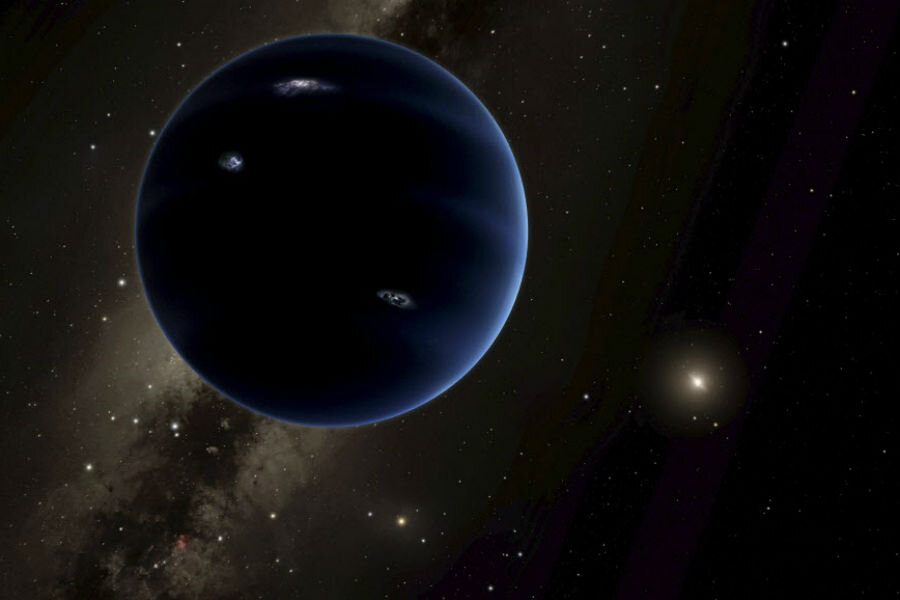Scientists spot ‘rebellious’ object orbiting beyond Neptune
Loading...
"I hope everyone buckled their seatbelts because the outer solar system just got a lot weirder," Michele Bannister, an astronomer at Queen's University in Belfast, Northern Ireland, tweeted on Monday.
Dr. Bannister was responding to the announcement that scientists have discovered an object on the outskirts of our solar system that's breaking all the rules. They dubbed the trans-Neptunian object (TNO) Niku, the Chinese word for "rebellious."
Appearing 160,000 times fainter than Neptune and measuring less than 200 kilometers in diameter, Niku caught scientists' eye as it travelled where orbiting bodies aren't expected to go: above the plane of the solar system. And to add to the intrigue, Niku revolves around the sun backwards.
Virtually all the objects in the solar system orbit in the same direction and stick close to a flat plane. For orbiting bodies to break from the plane – that's a rarity, explains Wesley Fraser, of the Astrophysics Research Center in Belfast, Northern Ireland.
The formation of the solar system, whose bodies formed from a disk of debris orbiting our sun, got everything going the same direction.
"Just as a figure skater who is spinning draws his arms in, and water in a sink continues to rotate as it gets to the drain, as stuff gets closer together, the angular momentum of the spin is preserved," Dr. Fraser tells The Christian Science Monitor. Since the molecular cloud that formed our galaxy was rotating as it collapsed down to form clouds and solar systems, that rotation, too, has been preserved.
"This is why the sun spins the way it does, why everything orbits around the sun the way it does, and why all the spinning planets basically spin in the same direction with only a few exceptions," says Fraser.
Ever the rebel, Niku travels backward on a plane that's tilted 110 degrees from the plane of the rest of the solar system, essentially forging its own perpendicular path. It's not entirely alone, but traveling with five companions, according to a paper published to the open-access journal arXiv, and accepted by Astrophysical Journal Letters.
Niku, and the five trans-Neptunian objects that match its path, have a secret to reveal, researchers believe. "There must be some other object out there or some other factor we’re not considering to explain why they’re all aligned," says Matthew Payne at the Harvard-Smithsonian Center for Astrophysics.
A similar discovery of six objects in the Kuiper Belt, a region of icy bodies beyond Neptune, whose orbits tilted away from the plane of the solar system, led scientists to predict the existence of a ninth planet 10 times the mass of the Earth lurking in the far reaches of the solar system and exercising its gravitational pull on the bodies.
Researchers initially posited that this hypothetical ninth planet might explain the movement of Niku and its siblings, too, but the pattern didn't fit. Planet Nine would likely be too far away from Niku to influence its orbit, for starters.
"When we looked at the details, we realized that the alignment the ninth planet causes pointed one direction, and the alignment of Niku and its brothers and sisters pointed in pretty much a perpendicular direction to that," Dr. Fraser tells the Monitor. The researchers also couldn't make a compelling case for a different dwarf planet to be pulling them off course.
The mystery remains as to how Niku and its companions adopted their unconventional path. "They either have to start their life like that and be stable like that or be kicked out of their orbit," Richard Wainscoat, who was also involved in the paper, tells the Monitor. In order to understand the story behind Niku, scientists hope to discover others like it, and they strongly suspect there are more to be found.
The discovery of Niku came out of a general-purpose survey that wasn’t specifically designed to find things in the outer solar system. But researchers using the Pan-STARRS telescope developed at University of Hawaii's Institute for Astronomy managed to spot Niku 22 times.
Scientists have been focused on the plane where most of the planets are located, according to Dr. Wainscoat of the University of Hawaii Honolulu Institute of Astronomy, but now they have a reason to turn their gaze beyond the plane of the solar system more often.
Typically, Fraser says, when scientists uncover something strange, they look toward the solar system for clues to understand it. But in this case, none of the proposed answers, like a hidden ninth planet have proven satisfactory and scientists might have to look even further afield.
"What I'm thinking is that the force that causes this alignment may very well be external to the solar system. It might be a residual of some particular stellar flyby from when the sun was forming out of that cloud," Fraser says. "These are the wild speculations that pop into my head before I fall asleep at night."






